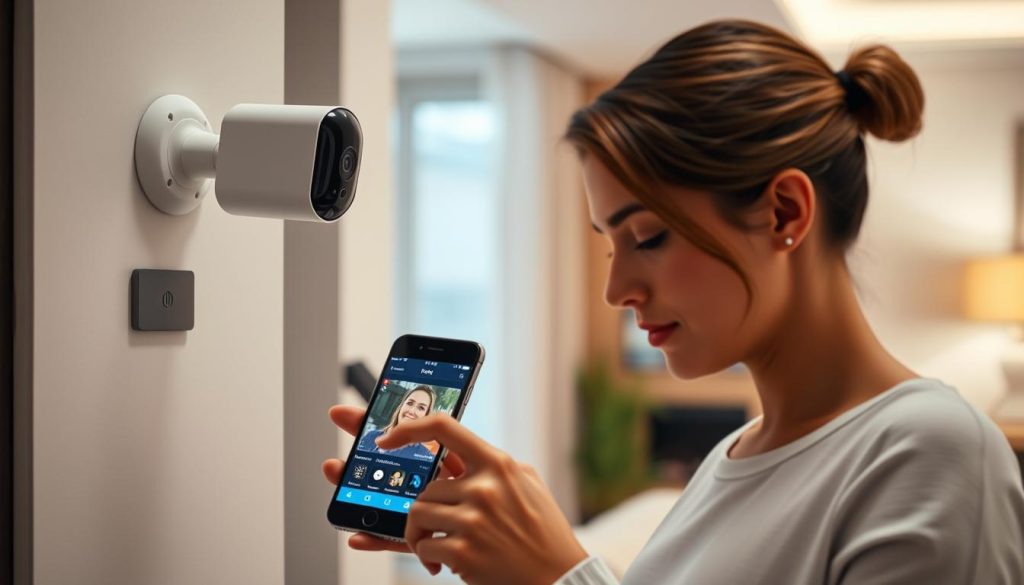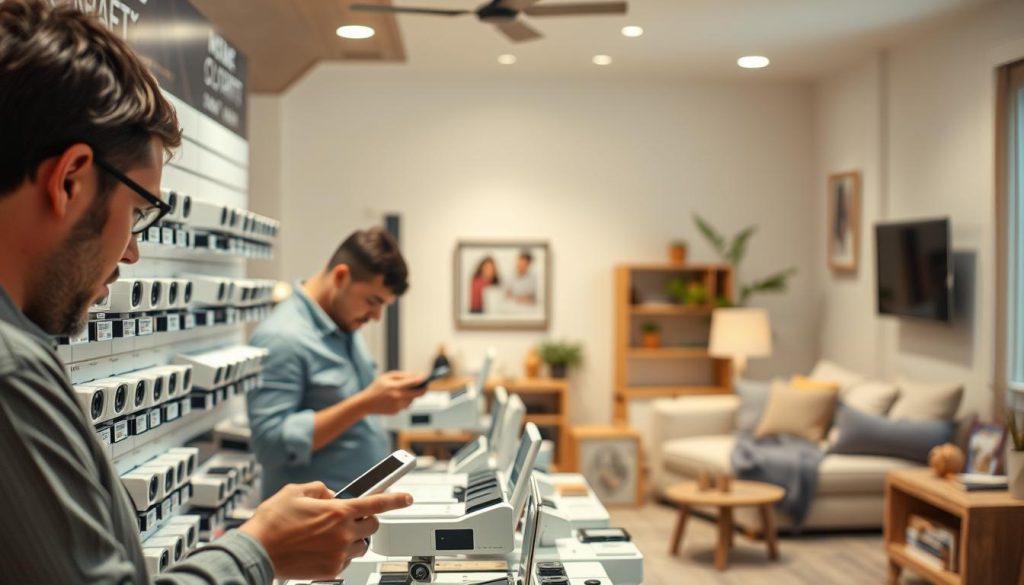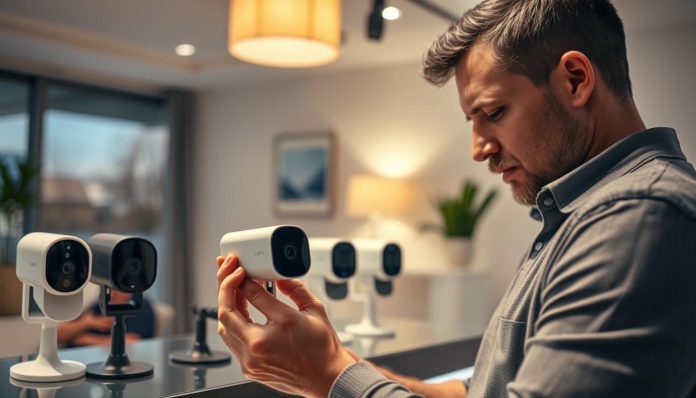You want to feel safe and secure in your own home. A reliable security camera system can give you that peace of mind. Now, with affordable security cameras, it’s easier to protect your property without spending a lot.
Local storage options are becoming more popular. They let you store footage on a physical device, not just in the cloud. This makes your security better and saves money over time.
Recent reviews have shown the best budget options. These cameras offer great value for their price. In this article, we’ll look at these top cameras. We’ll help you choose the right one for your security needs.
Key Takeaways
- Affordable security cameras with local storage are gaining popularity.
- Local storage enhances security and provides cost-effectiveness.
- Top-rated budget cameras offer a great balance between price and performance.
- These cameras provide peace of mind and protect your property.
- Choosing the right camera depends on your specific security needs.
Why Choose Home Security Cameras with Local Storage?
Home security cameras with local storage are becoming more popular. They help cut down on cloud storage costs and fees. This is because people want affordable and safe ways to watch over their homes.
One big plus of local storage is saving money on cloud storage fees. You can keep your footage on devices like MicroSD cards or NAS units. This is a one-time investment instead of a monthly bill.
Understanding Local Storage Benefits
Local storage has many benefits, like better privacy and security. It keeps your footage safe from cloud storage risks. Security experts say, “Local storage adds security by keeping data on your premises, away from the cloud.”
“Local storage can provide an additional layer of security by keeping your data on premises and out of the cloud.” – Security Expert
Also, local storage means you can get to your footage faster. You don’t need the internet to see your recordings. This is really helpful in emergencies when time is critical.
Comparing Cloud Storage vs. Local Storage
Cloud storage is convenient because you can access your footage anywhere. But, it has subscription fees and security risks. Local storage is cheaper and safer but needs more hands-on work.
Choosing between cloud and local storage depends on what you need. If you want to save money and keep your data safe, local storage is a good choice for home security cameras.
Key Features to Look For in Budget Cameras
Choosing the right budget home security camera is important. You need to think about key features like resolution, night vision, and motion detection. These features help your camera work well for home surveillance.
Resolution and Image Quality
The camera’s resolution affects how clear the images are. A higher resolution means you can see more details. For a good budget camera, look for at least 1080p (Full HD) resolution.
Some cameras even offer 2K or 4K resolution. This gives you even clearer images.
Key considerations for resolution include:
- Minimum resolution of 1080p for clear images
- Higher resolutions like 2K or 4K for more detailed footage
- The field of view and how it affects the area covered
Security experts say resolution is key. It helps the camera capture clear details.
“A higher resolution can significantly enhance the usefulness of the footage, making it easier to identify individuals or details.”
Night Vision Capabilities
Night vision is crucial for home security cameras. It lets them work in low light. There are different types, like infrared (IR) and LED night vision.
| Night Vision Type | Description | Range |
|---|---|---|
| Infrared (IR) | Uses IR LEDs to illuminate the area | Up to 30 feet |
| LED Night Vision | Employs visible LED lights for illumination | Up to 50 feet |
Make sure your budget camera has good night vision. Choose one that fits your needs.
Motion Detection Features
Motion detection is a key feature for home security cameras. It alerts you to any movement. Advanced motion detection can tell the difference between people, animals, or vehicles.
Benefits of motion detection include:
- Real-time alerts to potential security breaches
- Reduced false alarms with advanced detection technology
- Customizable sensitivity to suit different environments
By focusing on resolution, night vision, and motion detection, you can find a budget camera that meets your needs.
Top Affordable Home Security Cameras
Securing your home on a budget is easier than you think. Many home security cameras are affordable and effective. Each one has special features for different needs.
Wyze Cam v3: Features and Benefits
The Wyze Cam v3 is a top pick for budget-friendly home security. It offers 1080p resolution and night vision. Plus, it has motion detection and works with smart home devices.
It’s also great because it supports local storage. This makes it a cost-effective choice.
Blink Outdoor: Why It’s a Great Choice
Blink Outdoor is perfect for those on a budget. It has a long battery life and is weather-resistant. This makes it perfect for outdoor use.
The camera also has motion detection. It sends alerts to your phone when it detects activity.
Reolink Argus2: A Versatile Option
The Reolink Argus2 is versatile and affordable. It offers wireless connectivity and rechargeable batteries. It also has motion detection and records in 1080p resolution.
One of its best features is its use indoors and outdoors.
These cameras are highly rated for their performance and price. They’re excellent choices for anyone wanting to improve their home security without spending a lot.
Installation Process for Budget Cameras
Setting up budget-friendly home security cameras is easy without professional help. Many are made for DIY installation. This makes it simple to start watching over your home.
DIY Installation vs. Professional Help
Installing your budget home security cameras can be done by you or a pro. DIY is often chosen for saving money and flexibility. Most cameras come with easy-to-follow instructions and don’t need much tech know-how.
Benefits of DIY Installation:
- Cost savings on installation fees
- Flexibility to adjust or move cameras as needed
- Immediate setup and start of monitoring
Setting Up Local Storage Options
Setting up local storage for your budget cameras is key for safe footage storage. Options like microSD cards or NAS devices keep your recordings safe. This way, you don’t have to rely on cloud storage.
| Storage Option | Capacity | Ease of Use |
|---|---|---|
| MicroSD Cards | Up to 512GB | Easy |
| NAS Devices | Multiple TBs | Moderate |
Choosing the right local storage solution depends on your specific needs and the number of cameras you are using.
Monitoring Your Home Remotely
Mobile apps for security cameras let you watch your home from anywhere. This gives homeowners peace of mind, knowing they can see their property anytime.
Benefits of Mobile Apps for Security Cameras
Mobile apps for security cameras have many benefits. You can see live footage, get alerts, and change camera settings from afar. This lets you act fast on any security issues, even when you’re not there.
Some key features of these apps include:
- Live streaming: See what’s happening in real-time.
- Motion detection alerts: Get notified when your camera spots movement.
- Two-way audio: Talk to people near your cameras through the app.
How to Customize Alerts and Notifications
Customizing alerts and notifications is important. It helps you stay informed without being bothered by unnecessary messages. Most apps let you adjust these settings to fit your needs.
To change these settings, follow these steps:
- Open your security camera app and go to settings.
- Choose the “Notifications” or “Alerts” option.
- Pick the events you want to be notified about, like motion or tampering.
By adjusting these settings, you make sure your security system works well. It protects your home without bothering you too much.
Integrating Security Cameras with Smart Home Devices
Integrating your security cameras with smart home devices can greatly improve your home’s security. It also makes your daily life more convenient.
By linking your security cameras to your smart home system, you can manage your home from one place. You can get alerts, watch live footage, and control other smart devices like lights and thermostats from one app.
Popular Smart Home Platforms
Many homeowners choose platforms like Amazon Alexa, Google Assistant, and Apple HomeKit. These platforms let you connect various smart devices, including security cameras, into one system.
- Amazon Alexa: Compatible with many devices, Alexa lets you control your smart home with your voice.
- Google Assistant: Works well with Google services and lots of smart devices.
- Apple HomeKit: Offers a safe and easy smart home experience for Apple users.
Compatibility Considerations
Before linking your security cameras to your smart home, check if they’re compatible. Not all cameras work with every platform.
| Smart Home Platform | Compatible Security Cameras | Key Features |
|---|---|---|
| Amazon Alexa | Wyze Cam, Blink Outdoor | Voice control, live viewing |
| Google Assistant | Reolink Argus2, Nest Cam | Voice control, seamless integration with Google services |
| Apple HomeKit | Logitech Circle, August Doorbell Cam | Secure integration, Siri voice control |
Make sure your security camera works with your smart home platform to avoid problems.

Maintaining Your Home Security Camera System
Keeping your home security cameras in good shape is key. Regular care makes them last longer and work better. It’s important for your home’s safety.
Regular Software Updates
It’s vital to keep your camera’s software current. Updates fix security issues, improve performance, and add new features. Here’s how to update:
- Visit the manufacturer’s website or app for updates.
- Download and install the update as instructed.
- Make sure your camera is online during the update.
Updates help avoid problems like connection issues or poor image quality. Enable automatic updates if you can.
Cleaning and Maintenance Tips
Don’t forget about physical upkeep. Dust, dirt, and weather can harm your camera’s quality. Here are some cleaning and maintenance tips:
- Use a soft, dry cloth to clean the lens.
- Regularly clean and check outdoor cameras’ housings.
- Keep the camera’s mount secure and adjust it if needed.
By following these easy steps, your cameras will keep working well. This gives you peace of mind and better home security.
Understanding Local Storage Options
To get the most out of your home security system, knowing about local storage is key. Local storage lets you keep footage on devices linked to your cameras, not in the cloud. This method gives you more control over your data and can save you money on subscription fees.
MicroSD Cards: How Much Storage Do You Need?
MicroSD cards are a top pick for local storage in home security cameras. They’re small and affordable. The storage you need depends on the camera’s resolution, how often it records, and how long you keep the footage.
For example, a high-resolution camera (1080p or higher) uses more space than a lower-resolution one. If your camera records all the time, you’ll need more storage than if it only records when it sees motion.
- Check the maximum capacity supported by your camera.
- Consider the camera’s recording settings and adjust accordingly.
- Plan for future expansion if you anticipate adding more cameras.
Network Attached Storage (NAS) for Enhanced Security
For a more powerful and expandable storage option, think about a Network Attached Storage (NAS) device. NAS devices are special storage units that connect to your network. They let many cameras store footage on one device.
NAS has many benefits, including:
- Centralized storage for multiple cameras.
- Enhanced security features, such as RAID configurations for data redundancy.
- Easier management and access to footage from a single interface.
When picking a NAS device, make sure it works with your cameras and can handle all your system’s storage needs.
Cost-Effectiveness of Budget Cameras
The cost-effectiveness of budget cameras depends on several factors. These include the total cost of ownership and any additional expenses. It’s important to look beyond the initial purchase price to understand their overall value.
Total Cost of Ownership Explained
The total cost of ownership for budget cameras includes the initial cost of the device. It also includes any additional hardware or software required. And it includes maintenance costs over time. To help you understand these costs, consider the following breakdown:
| Component | Initial Cost | Ongoing Costs |
|---|---|---|
| Camera Device | $100 | $0 |
| Memory Card | $20 | $0 |
| Cloud Subscription | $0 | $3/month |
| Total | $120 | $36/year |
This table shows how the initial cost and ongoing expenses add up. By understanding these costs, you can make a better decision about your budget camera investment.

Hidden Costs to Consider
There are several hidden expenses to consider when investing in budget home security cameras. These may include:
- Additional hardware requirements, such as cables or mounts
- Subscription fees for cloud storage or premium features
- Potential increases in electricity costs due to the camera’s power consumption
- Maintenance or repair costs over time
By knowing about these potential hidden costs, you can better assess the overall cost-effectiveness of your budget cameras. This helps you plan accordingly.
In conclusion, evaluating the cost-effectiveness of budget cameras requires a full understanding of both obvious and hidden costs. By considering the total cost of ownership and potential additional expenses, you can make a more informed decision. This decision aligns with your budget and security needs.
Legal and Privacy Considerations
When you install home security cameras, think about the legal and privacy issues. You have the right to protect your home. But, you must know the laws about surveillance in your area.
Understanding Local Laws on Surveillance
Surveillance laws differ a lot in different places. It’s important to know the laws in your area to stay out of trouble. Some places need you to tell people they’re being recorded. Others have rules about where you can put cameras.
Key Points to Consider:
- Check if there are any specific laws in your state or locality regarding video surveillance.
- Understand the requirements for notifying individuals that they are being recorded.
- Familiarize yourself with any restrictions on camera placement, especially in areas like bathrooms or bedrooms.
The National Conference of State Legislatures says, “Video surveillance laws vary by state. Some states have laws for cameras in places like schools or government buildings.”
“The use of surveillance cameras raises significant privacy concerns, and laws are evolving to address these issues.”
Best Practices for Respecting Privacy
To respect privacy with home security cameras, follow these tips:
| Best Practice | Description |
|---|---|
| Position cameras carefully | Avoid pointing cameras at your neighbors’ properties or public areas. |
| Notify visitors and family members | Inform people that they are being recorded, either through signage or direct notification. |
| Secure your camera’s footage | Use strong passwords and keep your camera’s software up to date to prevent unauthorized access. |
By being aware of legal issues and respecting privacy, you can use home security cameras well. This way, you can protect your home without violating others’ rights.
Real User Experiences and Recommendations
Real user experiences offer valuable insights into affordable home security cameras. They help us understand the benefits and challenges. By looking at what homeowners say, we can learn what to expect.
Success Stories from Affordable Camera Users
Many people have seen big improvements in their home security with affordable cameras. For example, the Wyze Cam v3 is loved for its simplicity and clear video. One user said, “
‘The Wyze Cam v3 has been a game-changer for our home security. It’s easy to set up and the video quality is excellent.’
“
Users of the Reolink Argus2 also share positive stories. They like its wireless setup and long battery life. Another user mentioned, “
‘We were able to place the Reolink Argus2 in several locations around our property without worrying about wiring. It’s been very reliable.’
“
| Camera Model | User Rating | Key Features |
|---|---|---|
| Wyze Cam v3 | 4.5/5 | High-quality video, easy setup, motion detection |
| Reolink Argus2 | 4.3/5 | Wireless design, long battery life, weather resistance |
| Blink Outdoor | 4.2/5 | Affordable, easy installation, motion detection alerts |
Common Challenges and Solutions
While many enjoy their affordable home security cameras, some face challenges. Internet connectivity and bandwidth are common issues. To solve this, make sure your router can handle the extra device. You might need to upgrade your internet plan too.
Storage capacity is another challenge. Using MicroSD cards or Network Attached Storage (NAS) devices helps manage storage. For instance, a user might say, “
‘We initially struggled with storage on our cameras, but switching to a NAS device solved the problem.’
By learning from others, we can make better choices for our home security. Whether you want something easy to use, wireless, or affordable, there’s a camera for you.
Conclusion: Finding the Best Budget Camera for You
When you think about boosting your home’s security, a budget camera with local storage is a smart choice. It’s affordable and keeps your property safe. Knowing the perks of local storage and what features to look for helps you pick the right one.
Key Takeaways
Now you know that cameras like Wyze Cam v3, Blink Outdoor, and Reolink Argus2 are great deals. When picking a camera, think about the resolution, night vision, and motion detection. Also, consider local storage options like microSD cards and NAS for more security.
Making Your Home Security Investment
Investing in home security means keeping your family safe. By choosing the best budget camera, you’ll feel more secure. Look for cameras that offer great value and consider systems with local storage and remote monitoring.

